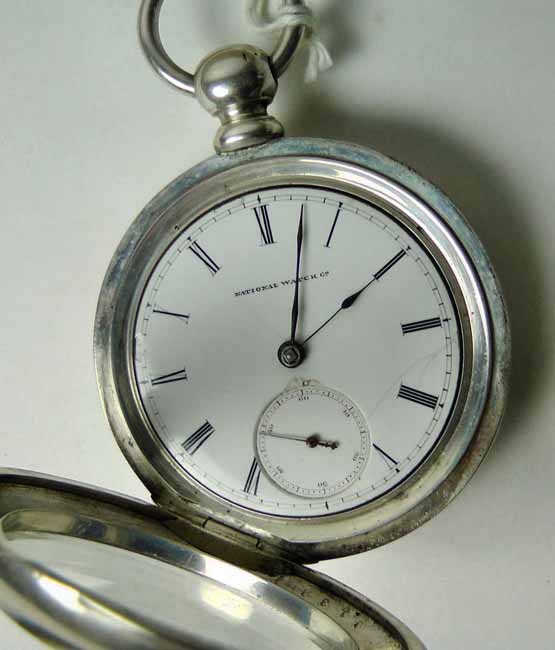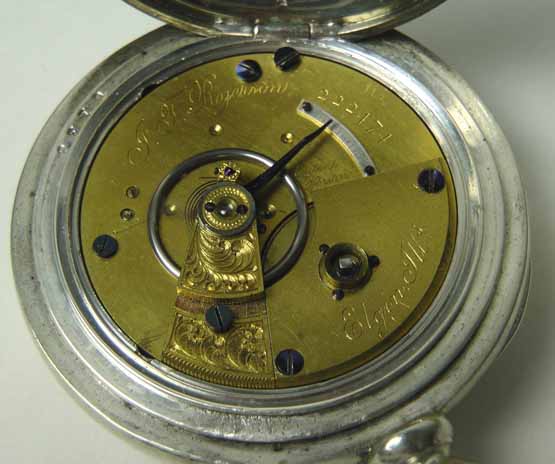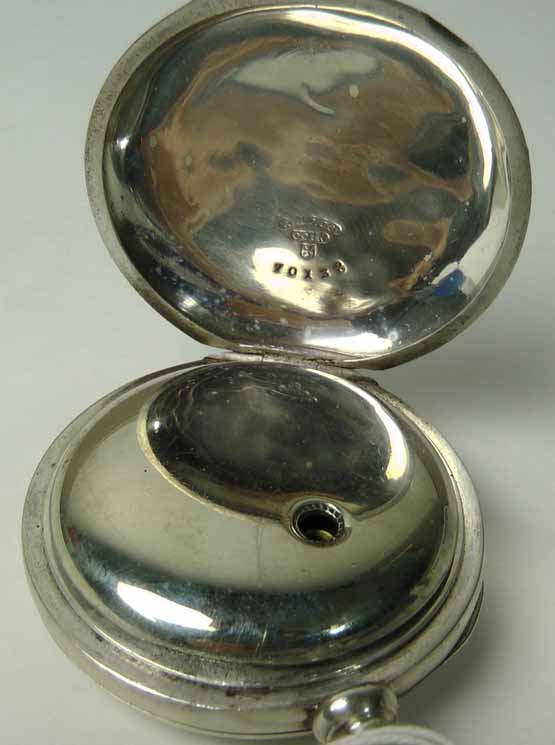
| WWT Shows | CLICK TO: Join and Support Internet Horology Club 185™ | IHC185™ Forums |

|
• Check Out Our... • • TWO Book Offer! • |
Welcome Aboard IHC185™  Internet Horology Club 185
Internet Horology Club 185  IHC185™ Discussion Site Main Page
IHC185™ Discussion Site Main Page  Horological Discussions, Questions and Answers
Horological Discussions, Questions and Answers  Pocket Watch Discussions
Pocket Watch Discussions  Early National
Early National
 Internet Horology Club 185
Internet Horology Club 185  IHC185™ Discussion Site Main Page
IHC185™ Discussion Site Main Page  Horological Discussions, Questions and Answers
Horological Discussions, Questions and Answers  Pocket Watch Discussions
Pocket Watch Discussions  Early National
Early NationalGo  | New Topic  | Find-Or-Search  | Notify  | Tools  | Reply to Post  |  |
Just received this 1874 National "Elgin" pocket watch. The case is not original to the movement which is common it seems when it comes to the key wind era, and the dial is far from mint. A good soaking should clean up the hairline at least. I'll live with the nibble between the 9 and 10 and the poor repair at the 60 seconds. The movement is a simple 7 jewel with a solid balance grade 55. I'm trying to locate a picture of Joesph T Ryerson that this model is named after. This movement ran from 1867 to 1876 and has the correct dial, but are the hands right along with the seconds hand? Any additional help is always appreciated. I'm just one of those guys who likes to dig up as much info on a watch as possible. Thank you, Roland R. Glenn  | |||
|
The movement. R. Glenn  | ||||
|
Elgin data base info R. Glenn  | ||||
|
This is all mounted in a A.W.C.Co 4oz coin case with a decent thick crystal. R. Glenn  | ||||
|
| IHC Life Member |
Roland, you have a very nice Grade 55 Elgin and I love the case.... You have a combination set of hands on the watch which is also common to these old Elgins and the maintenance thereof.... The hour hand and minute hand are correct for this movement, however not together...the hour hand is a #20 but the minute hand is a #2308 if you can find a #20 minute or a #2308 hour everything would be correct.... The second hand is also wrong, I don't know where it came from but the one you need is the #408 Elgin hand.... I hope this helps you and good luck....additionally, I would check with Brian C. pwpartsetc@pwatch.com here at IHC185, he may be able to help you in locating these correct hands.... Regards, Jerry | |||
|
Thank you Jerry for the info on the Hands...much appreciated. R. Glenn | ||||
|
| IHC Life Member |
Roland, I could have given this to you in the above post but did not.... Go here for the hands that I mentioned to see what they look like.... Hands, Hour & Minute Hands, Second Regards, Jerry | |||
|
Thanks again Jerry. I've been all over Wayne's site and passed on this catalog because it was from 1915. Gladly again appreciate the postings from both of you. Still need to find an image of J.T Ryerson. Maybe Tom can dig this up along with birth records etc. I have found images of the old the Ryerson Steel factories in and around Chicago, most of which are abandoned or have box stores on the land. One other thought about this movement. Why was the lessor jeweled movement still using a solid balance whereas the higher jeweled ones had the latest split compensated balances? I know the early Home "Waltham" ones were similar. Thanks again. R. Glenn | ||||
|
| IHC Life Member |
I think he solid balance wheel is simply a reflection of costs. The split compensated balance just cost more to make. Deacon | |||
|
| IHC Life Member |
Roland, while I agree with Deacon in one respect about the cost of the 'split balances' vs the 'solid balances', another factor to consider is the fact that the spilt balances were used in the higher jeweled movements because the higher jeweled movements were adjusted due to the certifications made necessary by the various requirements that were brought on by the Railroads and others....not to mention the plain old needs of marketing a more accurate watch.... Regards, Jerry | |||
|
| Powered by Social Strata |
| Your request is being processed... |
|
©2002-2025 Internet Horology Club 185™ - Lindell V. Riddle President - All Rights Reserved Worldwide

